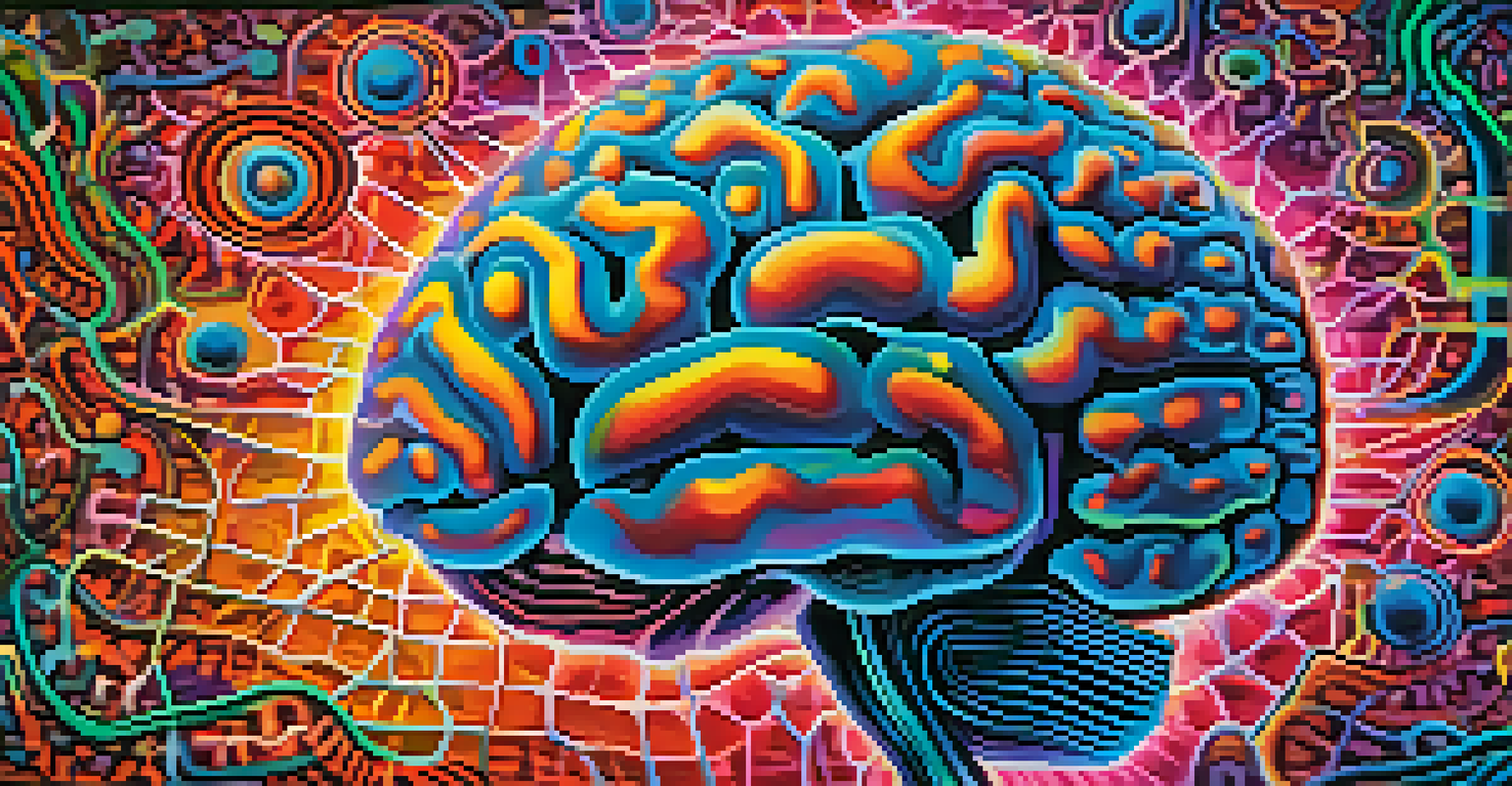Biological Mechanisms: How Peyote Affects the Brain

The Origins of Peyote and Its Active Compound
Peyote, a small cactus native to Mexico and the southwestern United States, has been used for centuries in indigenous spiritual practices. The key active compound in peyote is mescaline, a psychedelic that alters perception and consciousness. This ancient plant has a rich history in various cultures, often leading to profound experiences for those who partake in its use.
The experience of peyote is fundamentally a journey into the self, a path to understanding one’s place in the universe.
Mescaline is chemically similar to neurotransmitters like serotonin, which plays a significant role in mood regulation. This similarity allows mescaline to interact with serotonin receptors in the brain, primarily the 5-HT2A receptor. This interaction is crucial for understanding how peyote affects perception, mood, and cognition.
By examining the origins of peyote and its active compounds, we can appreciate its cultural significance and the scientific interest it generates. The unique properties of mescaline set the stage for exploring its biological mechanisms and effects on the brain.
How Mescaline Alters Brain Chemistry
When mescaline enters the bloodstream, it crosses the blood-brain barrier and binds to serotonin receptors. This binding triggers a cascade of chemical reactions that lead to altered states of consciousness. Users often report vivid visual hallucinations, enhanced emotional experiences, and a sense of interconnectedness with the universe.

The alterations in brain chemistry primarily affect the prefrontal cortex, a region responsible for decision-making and social behavior. This area becomes more active during a peyote experience, which may explain the introspective and reflective nature of these sessions. It's fascinating to see how a natural substance can significantly shift our cognitive processes.
Cultural and Historical Roots
Peyote has been used for centuries in indigenous spiritual practices, highlighting its rich cultural significance.
As we delve deeper into the chemical effects of mescaline, we start to understand the broader implications for mental health and therapeutic applications. By influencing brain chemistry, peyote holds potential for addressing various psychological issues, though more research is needed.
The Role of the Default Mode Network (DMN)
The default mode network (DMN) is a network of brain regions that is active when we are at rest and not focused on the external environment. Interestingly, psychedelics like mescaline can disrupt the normal functioning of the DMN, leading to a dissolution of the ego. This experience often results in feelings of unity and oneness with the world, a common theme among peyote users.
Psychedelics can offer a glimpse into the inner workings of the mind, revealing the interconnectedness of all things.
Disruption of the DMN during a peyote experience can also facilitate creative thinking and new perspectives. When the boundaries of the mind loosen, individuals may find themselves thinking outside the box and generating innovative ideas. This has led researchers to explore the potential of psychedelics in enhancing creativity and problem-solving skills.
Understanding the DMN's role in the effects of peyote highlights the complex interplay between brain networks and consciousness. As we gain insight into this relationship, we can better appreciate how peyote influences not just perception but also thought processes.
Visual and Auditory Hallucinations Explained
One of the most striking effects of peyote is the vivid visual and auditory hallucinations it can induce. These experiences can range from colorful patterns to complex imagery that feels incredibly real. The brain's visual cortex becomes hyperactive, leading to these extraordinary perceptions that can profoundly impact users.
Auditory hallucinations, often described as music or whispers, can also occur during a peyote experience. This phenomenon is linked to the brain's increased connectivity and altered processing of sensory information. As different brain regions communicate more freely, the lines between sensory modalities begin to blur.
Psychedelic Effects on the Brain
Mescaline alters brain chemistry, leading to enhanced emotional experiences and vivid hallucinations.
These hallucinations are not merely side effects; they can serve a purpose in the context of spiritual and therapeutic experiences. By understanding the mechanisms behind these sensory alterations, we can appreciate their significance in personal transformation and healing.
Enhanced Emotional Experiences with Peyote
Users frequently report intensified emotions while under the influence of peyote. This amplification can lead to profound feelings of joy, love, and even sadness, creating a rich emotional tapestry that can be both enlightening and challenging. The experience often encourages individuals to confront unresolved feelings or trauma, fostering personal growth.
The emotional effects of peyote may be attributed to its action on serotonin receptors, which are closely linked to mood regulation. By enhancing emotional sensitivity, peyote can facilitate deep introspection and self-discovery. This can lead to significant breakthroughs in understanding oneself and one’s place in the world.
Recognizing the emotional depth of peyote experiences opens doors to discussions about its potential therapeutic applications. As more people seek alternative treatments for mental health issues, peyote's ability to evoke and process emotions may play a critical role.
Therapeutic Potential of Peyote in Mental Health
In recent years, there has been a growing interest in the therapeutic potential of psychedelics, including peyote, for treating mental health conditions. Studies suggest that substances like mescaline can help alleviate symptoms of anxiety, depression, and PTSD by promoting emotional release and cognitive flexibility. This has sparked a renewed conversation about the role of traditional plant medicines in modern therapy.
Psychedelic-assisted therapy often incorporates guided sessions where patients can explore their thoughts and emotions in a supportive environment. The insights gained during these sessions can lead to lasting changes in perspective and behavior, making peyote a compelling option for those seeking alternative treatments.
Therapeutic Potential of Peyote
Growing interest in psychedelics like peyote suggests they may effectively treat mental health conditions such as anxiety and depression.
While research is still in its early stages, the potential benefits of peyote in mental health care cannot be overlooked. As societal attitudes toward psychedelics continue to evolve, we may see a broader acceptance of peyote as a legitimate therapeutic tool.
Cultural Significance and Responsible Use of Peyote
Peyote has deep cultural significance, especially among Native American tribes who use it in religious ceremonies. It is vital to approach peyote with respect for its cultural roots and the traditions that surround its use. Understanding these cultural aspects can enhance our appreciation of its effects and the experiences it can facilitate.
Responsible use of peyote is crucial, particularly as interest in psychedelics grows. This includes understanding dosage, setting, and personal intentions before embarking on a peyote journey. Education and awareness can help ensure that individuals have safe and meaningful experiences.

As we continue to explore the biological mechanisms of peyote, we must also honor its cultural significance and advocate for its responsible use. By doing so, we contribute to a broader understanding of psychedelics and their potential role in personal and collective healing.